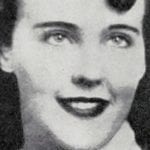 Weird Stuff
Weird Stuff  Weird Stuff
Weird Stuff  Animals
Animals 10 Inspiring Tales of Horses Being Human
 Mysteries
Mysteries Top 10 Haunting Facts About the Ghost Ship MV Alta
 History
History 10 Surprising Stories About the Texas Rangers
 Humans
Humans 10 Philosophers Who Were Driven Mad by Their Own Theories
 Miscellaneous
Miscellaneous 10 Video-Game-Worthy Weapons and Armors from History
 Weird Stuff
Weird Stuff 10 Psychics Who Accurately Predicted Wartime Events
 The Arts
The Arts 10 Pieces of Art Inspired by a Broken Heart
 Health
Health 10 Science Fiction-Sounding New Medical Treatments
 History
History 10 Surprising Facts About the Father of Submarine Warfare
 Weird Stuff
Weird Stuff 10 Times Real Laws Were Based on Bizarre Hypotheticals
 Animals
Animals 10 Inspiring Tales of Horses Being Human
 Mysteries
Mysteries Top 10 Haunting Facts About the Ghost Ship MV Alta
Who's Behind Listverse?

Jamie Frater
Head Editor
Jamie founded Listverse due to an insatiable desire to share fascinating, obscure, and bizarre facts. He has been a guest speaker on numerous national radio and television stations and is a five time published author.
More About Us History
History 10 Surprising Stories About the Texas Rangers
 Humans
Humans 10 Philosophers Who Were Driven Mad by Their Own Theories
 Miscellaneous
Miscellaneous 10 Video-Game-Worthy Weapons and Armors from History
 Weird Stuff
Weird Stuff 10 Psychics Who Accurately Predicted Wartime Events
 The Arts
The Arts 10 Pieces of Art Inspired by a Broken Heart
 Health
Health 10 Science Fiction-Sounding New Medical Treatments
 History
History 10 Surprising Facts About the Father of Submarine Warfare
10 Tragic Facts From The Dawn Of Aviation
For thousands of years, man has been eager to take to the skies and reach for the stars. From the days of hot air balloons all the way to stepping foot on the Moon, human beings have accomplished glorious feats, achieving more than one has ever envisioned. But such success required not only great courage and skill but enormous sacrifice that paved the way for modern aviation. The following 10 cases are not only the first of their kind but detail unfortunate events that ended tragically while attempting to make an imprint on history.
10 Yuan Huangtou
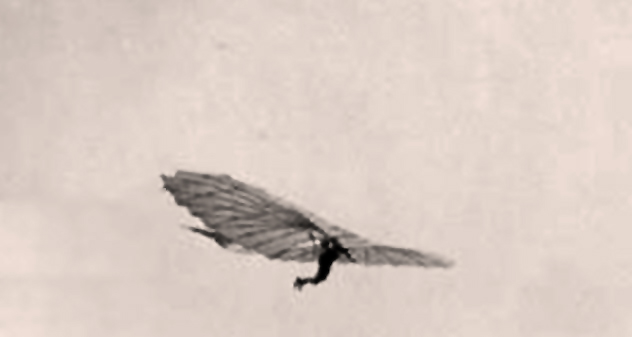
The first recorded use for a planar surface flight occurred in the year 559 AD in China when a young prince by the name of Yuan Huangtou of Ye soared more than 2.5 kilometers (1.5 mi) while strapped to a man-made kite. Those who had witnessed the event were left in astonishment, bewildered that something that had been built by man could carry a human through the air for such a long distance.
Unfortunately for Yuan Huangtou, it was not an experiment of his choosing. The young prince had been imprisoned and was used as a test rat along with 17 other prisoners. The men were harnessed to thick bamboo mats against their will and ordered to jump off the Tower of the Golden Phoenix.
Many believe the act was more of a botched execution as opposed to an experimental simulated flight as 17 of the prisoners fell to their deaths. However, as Yuan leaped from the tower, to everyone’s amazement, he glided over the city wall and out into the countryside. Unfortunately, he was unable to free himself from the harness upon landing and was soon recaptured and executed.
9 Tullamore, Ireland
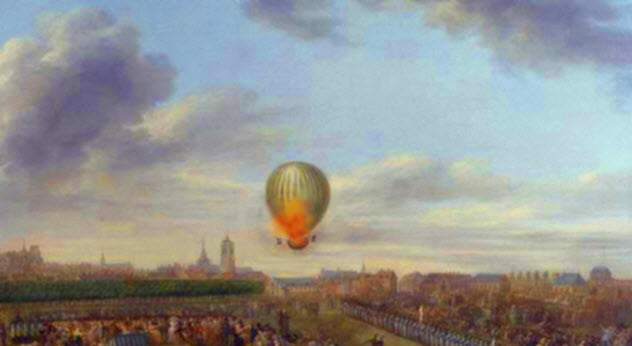
Perhaps the dawn of aviation truly began on December 1, 1783, when the first manned hydrogen balloon was launched in Paris by Professor Jacques Charles and the Robert brothers. Their flight lasted two hours and five minutes and sparked worldwide interest in aviation, paving the way for Jean-Pierre Blanchard to be the first man to fly across the English Channel on January 7, 1785. However, every new creation entails trial and error which would lead to the very first air disaster in aviation history on Tuesday, May 10, 1785.
That year, the citizens of Ireland had only just become familiar with air balloons and considered it a novel spectacle in which towns would gather to watch in admiration as people took to the skies. On that fateful day in May, the townspeople of Tullamore watched in horror as a hot-air balloon collided with a household chimney during a town fair, becoming engulfed in flames and setting fire to more than 100 homes.
Some bystanders were scorched and burned during the carnage. Despite the townspeople’s effort to extinguish the fire, it could not be put out, leading to the destruction of Patrick Street, the town’s most populated and main trading area. The horrific event will live on in Ireland as being one of the worst disasters in Tullamore as well as the world’s very first air disaster.
8 Thomas Etholen Selfridge
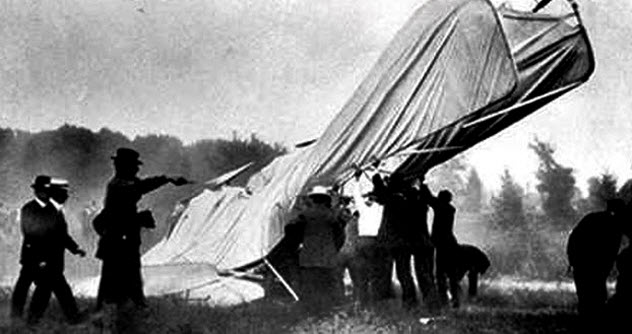
Thomas Etholen Selfridge was a young lieutenant who made history for becoming not the only the first military officer to fly solo but also the first person to die in a crash of a powered airplane. After graduating from the US Military Academy at West Point, New York, Selfridge joined the Aerial Experimental Association (AEA) as an observer for the United States government.
There, he worked beside the Wright brothers and was credited with designing the Red Wing, AEA’s first airplane. The second airplane that Selfridge designed was the White Wing where he gained notoriety on May 19, 1908, for being the first officer to pilot the aircraft on a flight of more than 30 meters (100 ft) by himself.
On September 17 of that year, Selfridge had agreed to be a passenger with Orville Wright at the controls of his newly designed Wright Flyer aircraft. During the flight, the aircraft flew 45 meters (150 ft) in the air, circling Fort Myer four times. On the fifth circuit, the airplane began to lose thrust after the right propeller broke off and sent the aircraft into a nosedive, crashing into the earth below.
Wright sustained a broken thigh, several broken ribs, and a damaged hip while Selfridge sustained a skull fracture. Selfridge underwent neurosurgery but succumbed to his injuries later that evening, becoming the first casualty in an airplane crash. At the time, Selfridge was not wearing any type of headgear, and as a result of his death at age 26, the US Army began to implement mandatory helmets for all pilots.
7 Matias Perez
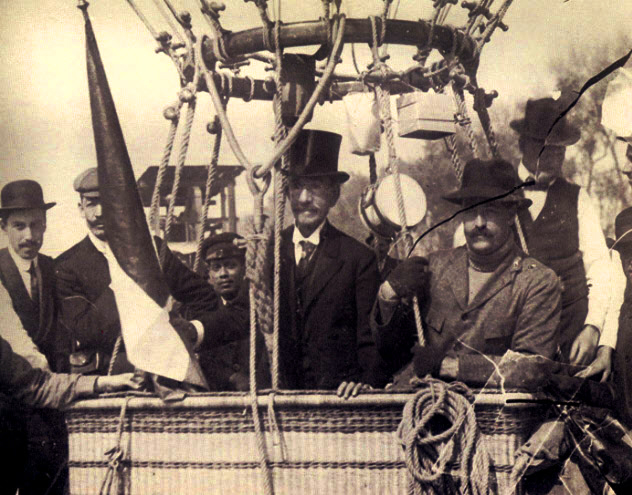
Matias Perez was a Portuguese citizen who immigrated to Cuba and began a successful business selling awnings and canopies. Although he was making a good living, his true passion was in aeronautics, having flown in a hot-air balloon once before with his friend Eugene Godard on May 21, 1856. That year, Perez purchased Godard’s hot-air balloon, Ville de Paris (City of Paris), for 1,200 pesos. On June 12, 1856, Perez made his first successful flight in the balloon in front of an enthusiastic crowd cheering him on.
Perez’s second flight took place on June 29, 1856, in front of an audience that included Cuba’s captain general as well as civil, religious, and military hierarchy. The winds were exceptionally strong that day, delaying the takeoff to just after 7:00 PM as the Sun was beginning to set. Although Perez was fully aware of the dangers, he refused to disappoint the thousands of spectators who had traveled and waited all day to see him lift off into the sky.
As he departed, the hot-air balloon quickly ascended and headed northwest, passing over the fortress and toward the sea. Perez was never seen again, becoming the first man to disappear in flight for reasons that have not been definitely determined. His disappearance coined the phrase, “Volo como Matias Perez” (“Flew like Matias Perez”), which is used when describing a person who disappears forever.
6 Lamb vs. Rader
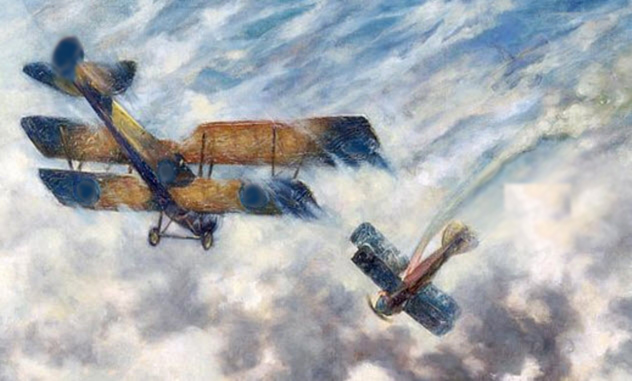
Sometime between 1913 and 1914 during the Mexican Revolution, the first aerial duel in history took place in the skies involving two pilots, forever becoming known as the original dogfight. The men at the center of the fight were American pilots Dean Ivan Lamb and Phil Rader, who were on opposite sides of the conflict.
Lamb, who was representing the Constitutionalists, engaged Rader, who was flying a Christofferson for Huerta over Naco, Arizona. Over the next 20 minutes, the two pilots fired their pistols at one another in midair. Given that there was no autopilot in such primitive aerial times, Lamb flew his airplane with his free hand while simultaneously placing his revolver between his knees to reload.
It was reported that on one occasion prior to the duel, Lamb had to force land his plane after his propeller was destroyed when an ejected object from his cockpit hit it. Therefore, Lamb was extra cautious during the dogfight and stored all the hot cartridge casings inside his shirt as opposed to discarding them in the sky. In the end, the two men fortunately went their separate ways with no injuries and no recorded hits but most certainly a story to tell for the rest of their lives.
5 Denise Moore
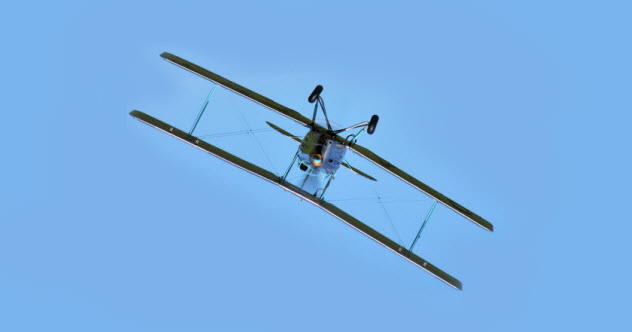
In 1922, Mrs. E.J. Cornesson was a widow who used the pseudonym “Denise Moore” to hide her identity. She did so because she took up the hobby of aviation and being the former Miss E. Jane-Wright prior to her marriage, she did not want her family to discover her newfound passion for flying.
While living in France, she quickly became a popular figure in aviation circles, a feat which was rare for women in those days. At the time, she had been taking flight lessons at the Henri Farman Aviation School at Etampes, located about 50 kilometers (30 mi) south of Paris. Shortly after 6:20 PM on July 21, 1921, “Denise Moore” was making her third flight of the day, circling the field on two successful occasions. On her third attempt, the biplane in which she was navigating banked steeply and pitched downward.
At the time, Moore was flying at a height of 40 meters (120 ft) and her aircraft was described as becoming “turtled.” That meant it had flipped upside down in midair. This caused Moore to become pinned under the motor where it was presumed she died instantly. Regardless, Moore’s aircraft ultimately crashed and she was killed. She became not only one of the first women to take to the skies but the very first woman to be killed in an aircraft.
4 Shot Out Of The Sky
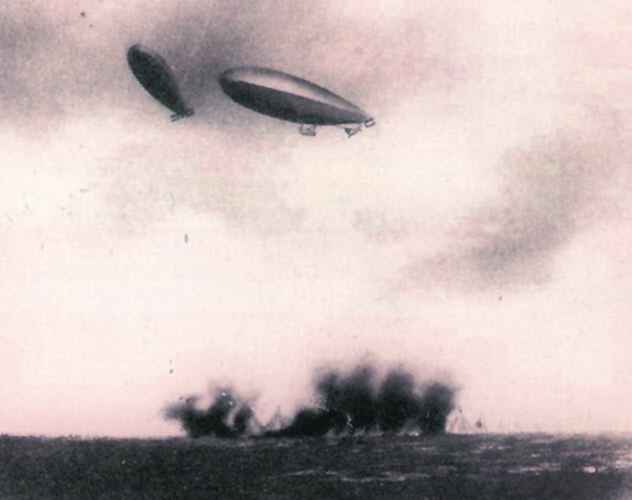
This list has seen its share of disasters and carnage, claiming the lives of countless people in the process. What is so intriguing about this particular case is not the fact that it was the first airplane to ever be shot out of the sky but the means as to how it occurred.
During the Italo-Turkish War of 1911–1912, which took place in the Ottoman province of Tripolitania (modern-day Libya), the war eventually spread to the Adriatic Sea, the Aegean Sea, and the Red Sea. As the war progressed, so did the growing demand for military efficiency and strength, ultimately leading to a number of technological advancements.
This was the first war in that hemisphere to see the use of airplane warfare. As reconnaissance and bombing missions occurred throughout the Ottoman Empire, the number of casualties grew exponentially. Unfortunately, the Turks did not have antiaircraft artillery and were forced to use their rifles as their only defense against the enemy which soared hundreds of feet above.
These events led to the first antiaircraft operations in history. The Turks were recorded as the first to shoot down a plane using nothing but a rifle. Although the war was deemed small, it sparked the attack by the Balkans on the Ottoman Empire and was the precursor to World War I.
3 Didier Masson And Captain Joaquin Bauche Alcalde
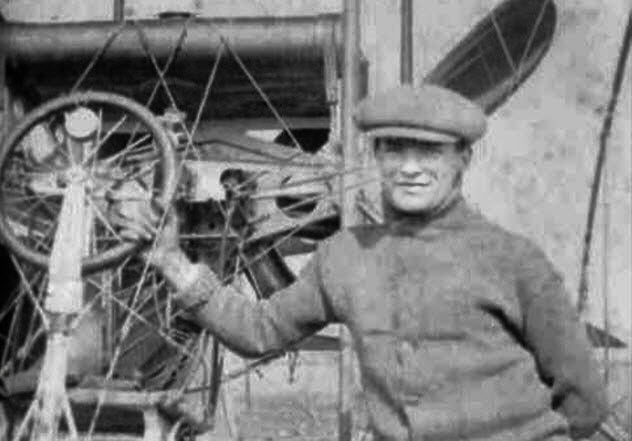
In January 1913, Didier Masson of France earned his flying certificate in California, only to be contracted as a mercenary flyer for Revolutionist Pancho Villa during the Mexican Revolution. Masson, who flew a pusher airplane, had managed to smuggle the aircraft into Mexico via Arizona.
One of the men who aided Masson in smuggling the two-passenger airplane into enemy territory was Captain Joaquin Bauche Alcalde. The two went on flying missions together with the intentions of attacking Federalist gunboats, and on May 10, 1913, Masson and Captain Bauche pulled off the first bombing of a surface ship to ever take place in the western hemisphere.
At the time, aerial attacks were unheard of and impossible to foresee, casting fear in the hearts of the enemy. On that day in May, Captain Bauche and Masson improvised pipe bombs containing 15 kilograms (35 lbs) of explosives, dropping the dynamite over five Mexican gunboats. Many of the crew members below leaped overboard into the water out of fear and panic from an assault unheard of at the time.
Masson continued flying bombing missions until the end of the war, eventually returning to France where he served in the famed Lafayette Escadrille during World War I. After the war, he returned to Mexico where he died in June 1950.
2 Caproni Ca.48
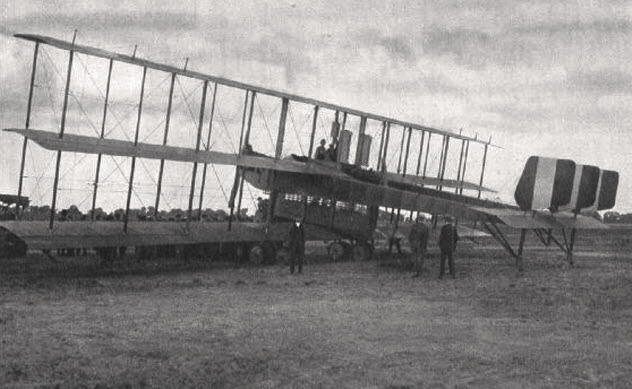
Gianni Caproni of the Caproni Works designed the successful Ca.3, ultimately leading him to design the Ca.4s which were tested by the Italian Air Force in 1917 and began operations in 1918. The Ca.4s, although unstable and fragile in appearance, were well designed.
The body consisted of a wooden, fabric-covered frame configured with a three-engine, twin-fuselage design allowing for much faster speed. This led to the design of Caproni’s Ca.48, a large commercial triplane which was a conversion of the Caproni Ca.42 heavy bomber used during World War I for missions over Austria-Hungary.
Unfortunately, not all flights in the Ca.48 would prove successful. On Saturday, August 2, 1919, the Caproni Ca.48 took off from the Milano-Taliedo Airport in Italy for a flight to Venice, where it arrived without incident. Later that afternoon, the commercial aircraft departed Venice to return to Taliedo.
As the plane passed near Verona at an altitude of 900 meters (3,000 ft), the wings began to flutter and break apart. Eyewitnesses reported that several of the passengers jumped from the aircraft to their deaths before the plane ultimately crashed to the ground.
In total, 12 passengers and two crew members were killed, although different sources put the death toll at 14 to 17. The significance of the crash was that it was the first commercial aviation disaster in history with nonmilitary civilians on board.
1 The Hindenburg Disaster
No list of tragic events regarding the dawn of aviation would be complete without the mention of the Hindenburg disaster. The airship, which could travel the world in half the time of the fastest ocean liner, was equipped with luxurious interiors for the passengers. This included an elegant dining room, comfortable cabins, and a smoking room with an aluminum piano in a modern lounge.
Hindenburg’s last flight departed on May 3, 1937, from Frankfurt, Germany, and arrived in New Jersey three days later under harsh weather conditions. Anxious to land before weather conditions became worse, Captain Pruss executed a sharp, tight turn to line up for landing in strong winds.
Experts theorize that this maneuver overstressed the ship, causing the bracing wire to snap and slash a gas cell. This allowed hydrogen to leak, causing a fire due to a spark from an electrostatic discharge. Flames quickly spread, engulfing the airship, and within 32 seconds, the Hindenburg was destroyed.
Many passengers and crew members jumped out of the promenade windows to escape the burning ship, but those deeper inside within the cabins at the center of the decks burned to death in the fire. In the end, 35 people were killed along with one member of the ground crew. Surprisingly, 62 of the 97 passengers and crew survived, primarily by jumping to safety. After more than 30 years of passenger travel on commercial zeppelins, the era of airship travel was forever brought to an abrupt end.
Adam is just a hubcap trying to hold on in the fast lane.

